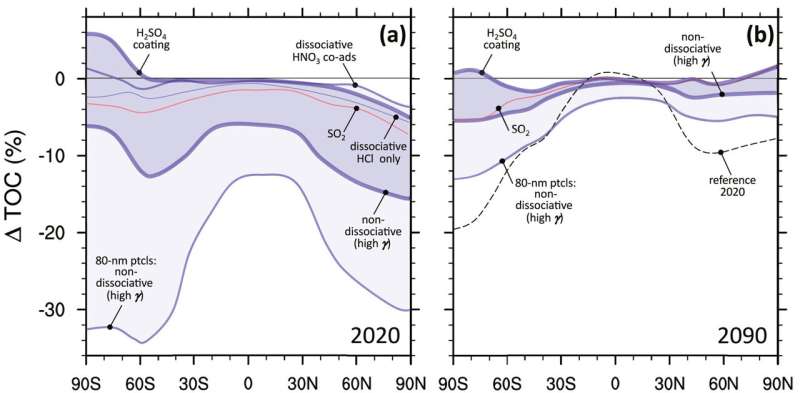This article has been reviewed according to Science X's editorial process and policies. Editors have highlighted the following attributes while ensuring the content's credibility:
fact-checked
peer-reviewed publication
trusted source
proofread
Uncertainty abounds in seeding the sky to fight climate change, says study

As greenhouse gas levels increase in Earth's atmosphere, scientists are considering ways to temporarily limit rising temperatures. One idea is to inject aerosols into the stratosphere to reflect incoming sunlight, thereby reducing global warming and its associated risks.
Most previous research has focused on using gaseous sulfur dioxide, which is also released in volcanic eruptions. However, the injection of sulfur dioxide into the stratosphere is associated with side effects including ozone depletion and local stratospheric heating.
Recent studies have shown that the use of solid materials such as alumina, calcite, or even diamond particles could more effectively cool the climate while simultaneously reducing these side effects. However, there is limited understanding of how solid material injection affects the stratospheric ozone layer. The current understanding is based on scant, decades-old experimental data on alumina particles emitted into the stratosphere via solid-fuel space rocket exhaust.
In new research published in Geophysical Research Letters, Sando Vattioni and colleagues show that stratospheric conditions resulting from space shuttle exhaust plumes are not comparable to alumina injection scenarios for climate intervention. They found that although alumina injection may have an advantage over sulfur dioxide in terms of reduced local stratospheric heating, there are "significant uncertainties" in estimating such injections' impact on the ozone layer.
The scenarios they tested would inject about 5 megatons of alumina particles into the stratosphere per year, which would compensate for about a quarter of the present-day radiative forcing caused by anthropogenic greenhouse gas emissions. The researchers estimate that the global mean ozone loss from these scenarios could range from negligible to as much as 9%, which is about twice the historical peak of ozone loss from chlorofluorocarbons in the 1990s.
The authors note that more research is needed on the potential surface reactions of solid particles in the atmosphere. In particular, this means learning more about surface reactions under present and future stratospheric conditions with respect to temperature, trace gas concentrations, and relative humidity. Improving this understanding could help reduce the uncertainty over how solid particles might behave when injected into the stratosphere for climate intervention.
More information: Sando Vattioni et al, Chemical Impact of Stratospheric Alumina Particle Injection for Solar Radiation Modification and Related Uncertainties, Geophysical Research Letters (2023). DOI: 10.1029/2023GL105889
Journal information: Geophysical Research Letters
Provided by American Geophysical Union
This story is republished courtesy of Eos, hosted by the American Geophysical Union. Read the original story here.





















